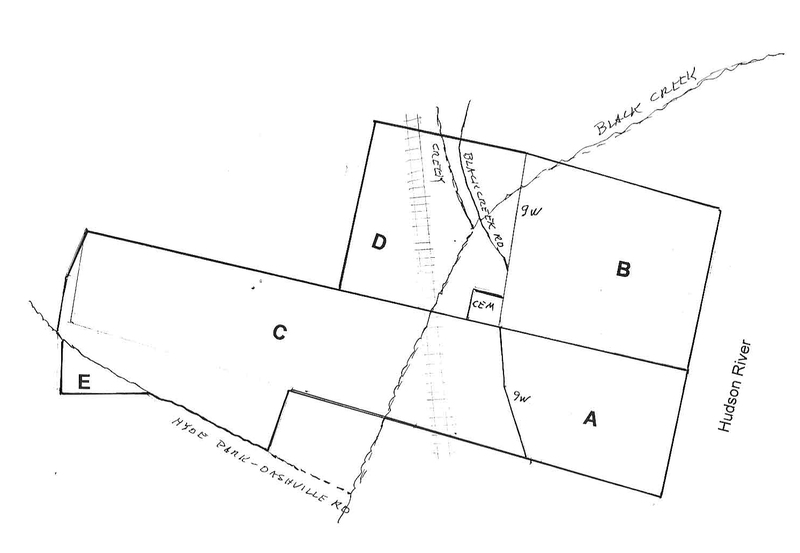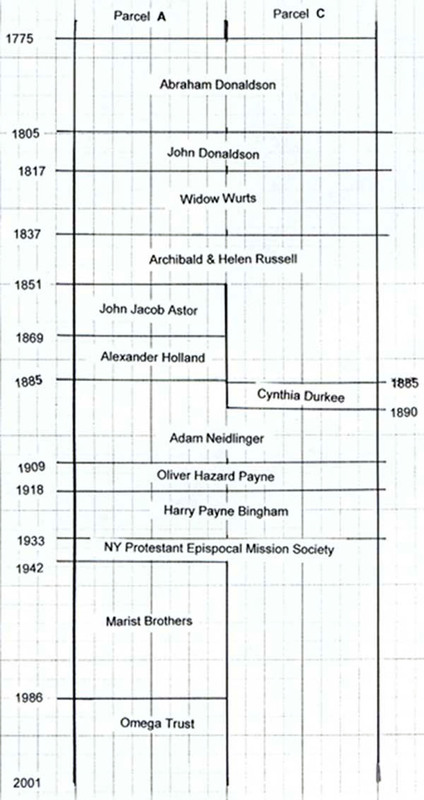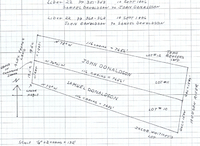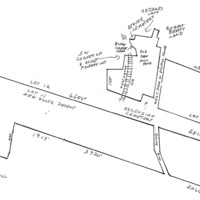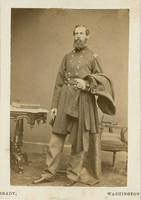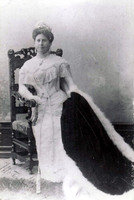History of Property Ownership
Esopus was sparsely settled during the seventeenth and eighteenth centuries. In the nineteenth century, the Hudson Valley became the site of many manor homes or summer homes for affluent families living in Manhattan or Brooklyn. The east shore was developed first as the railroad laid down in the 1840s provided convenient transportation out of the city. The west shore was more difficult to develop, since no railroad existed until 1881. Most of the materials transported to build the estates was brought by boat, and offloaded at landings along the shore. Technically such landings required permission from New York State, but Archibald Russell is the only one I could discover who took the trouble to petition the legislature and hereceived such authorization in 1845.
President Emeritus Richard Foy created all the content on this page and divided the Esopus property into parcels, A, B, C, D, and E as seen on the map above. He has traced the history of parcels A & C back to the 1750s. The history of the other parcels has not been completed but information about them is divided up by parcel location.
Parcels A & C
New York Protestant Episcopal Mission Society
Parcels Across 9-W
Philip Hellreigel & James R Shields: Wildwycke Village Inc
Northern or Pratt Slice
Miscellaneous Parcels
By President Emeritus Richard Foy
The logical structure of the Payne property is described elsewhere, and I shall describe the owners in relation to the parts of the property they occupied. I was able to track the owners of the southern parcels A and C back to the 1750s, and the time line of their occupancy is as follows:
Abraham Donaldson was a prominent landowner in the 1700's and directed the local militia during the American Revolution. A Cynthia Donaldson is the first Donaldson deed on record in the Kingston vault, dated 17xx. Abraham Donaldson engaged in multiple land deals. When he died in 1805, he willed lots #10 and #11 of the New Paltz patent to his two sons, Samuel and John Donaldson.
In 1806, the brothers agreed to split ownership, Samuel taking the lower half of the territory, and John taking the upper half, which corresponds to the location of the Payne mansion and the land across route 9-W.
-The structure of the Donaldson lots gives a good picture of how the New Paltz patent lots were designed. They are called the three mile or River lots. Each lot extended three miles to the west of the Hudson River, and took 24 chains or 1584 feet along the shore, The lots seemed to be split in half, with Alexander Young owning several of the western parcels. The lower half of the Payne estate corresponds roughly with lot # 11.
John Donaldson occupied lot # 11. When he died in 1817, he left eight young children. The brothers had reached agreement on splitting the land in 1806, but the agreements were not filed with the county until 1817. Since John Donaldson had debts outstanding, his property was auctioned off, and after passing through brokers' or speculators' hands, it was sold to
the Widow Wurts. She owned the land until 1837, but it is not known if she ever lived there. Her deed describes her as living in New Paltz, but the lots #1 through #12 were considered part of New Paltz until the late 1840s. The Wurts name appears often in Ulster County, and there is a Wurts Street in Kingston. One of the county clerks on our deeds was a Wurts. William Wurts and his brother Maurice had the original idea to send coal from Pennsylvania to New York through a canal, and they organized the Delaware and Hudson Canal which terminated in Kingston. The company was formed in 1826 and the canal opened in 1828. The town of Wurtsboro in Sullivan County is named in their honor. In 1837, Maria Wurts sold lot # 11 to
James Duane Pell, a son of Alfred Sands Pell, who with Robert Livingston Pell had inherited land in Esopus from his father. James Pell paid $8,000, of which $7,000 was in the form of a five year mortgage to the Widow, with a balloon payment due in 1842. Pell held on to the land for only three years, and sold the tract in 1840 to
Archibald Russell (b 24 Dec 1811 - d 17 April 1871) who came to America in 1836 from Scotland and was married to Helen Rutherford Watts, a daughter of the prominent Stuyvesant-Rutherford New York City family. Archibald was the son of James Russell (1754 - 1836), regius professor of clinical surgery at Edinburgh University and grandson of James Russell, professor of natural philosophy at Edinburgh. Archibald's father was one of the original fellows of the Royal Society of Edinburgh and served as vice-president of the society. Sir Walter Scott was a member during the same time period. Archibald graduated from the University of Edinburgh in philosophy, law, and medicine, and subsequently studied at the University of Bonn, Germany .
The name Archibald Russell is very common in Scotland. The Russells operated several coal and lead mines in Scotland. One Archibald Russell became a naval architect in the 19th century, and in 1905 a steel-hulled ship was built in Glasgow and named the Archibald Russell; it was used for shipping products from Indonesia and Australia. Another Archibald Russell established tea plantations in Indonesia; and in the 20th century, an Archibald Russell was the chief designer of the SST, the supersonic transport developed by Britain and France.
In New York City, our Archibald Russell devoted his time and fortune to benevolent and educational enterprises, founding the Five Points House of Industry, of which he was president for eighteen years, and aiding in establishing the Half-Orphan asylum, of which he was a vice-president. The Five Points House of Industry, which had been an association for the amelioration of the condition of the children of that and the adjacent neighborhoods, was incorporated in 1852 by the zealous services of Archibald Russell. Its purpose was to induce children to school, to clothe and feed them, to afford outdoor relief and a hospital. Five Points was a squalid neighborhood in Manhattan named for the intersection of five streets: Mulberry, Worth, Park, Baxter and the now defunct Little Water Street. The area was swampy and abutted a large pond known as the Collect (now Foley Square). The Collect was filled in as a public works project in 1808, but later began to sink. Buildings collapsed, the area stank, and prosperous residents left. Some of the remaining residents were freed blacks, Jews, and destitute Irish immigrants, whose number was exceeded only by that of Dublin. It became a dangerous slum, ruled by Irish gangs and later Italian gangs until 1887, when the city acquired and condemned most of the tenements and a ramshackle brewery.
Russell was an active member of the Christian commission during the Civil War, gave largely to its support, and was chairman of the famine relief committee. He was also a member of the Masonic Lodge #8, where John Jacob Astor was also a member. The group held its meetings in German, in which Russell was comfortable from his education at Bonn, Germany. He was a member of the Church of the Ascension (at Fifth Avenue and 10th street). He published "Principles of Statistical Inquiry" (New York, 1839), and "Account of 11,000 Schools in New York" (1847).
Archibald was an important force in designing improved census data. The statisticians of New York and Boston led the fight for census reform. In 1848 memorials from the New York Historical Society and the American Statistical Association, drafted by Archibald Russell and Lemuel Shattuck respectively, launched the effort. The burden of their advice was to start planning early and to utilize statistical experts. In Congress, a bill was passed creating a Census Board to plan the schedules for the seventh enumeration. The Secretary of State, the Attorney General, and the Postmaster General constituted the Board. Rather than appoint a statistician to commence the work, they chose instead Joseph C. G. Kennedy of Pennsylvania, whose political credentials as a fervent Whig were impeccable. Kennedy, a lawyer and journalist, soon needed expert advice, so Russell and Shattuck were called to Washington to be his statistical consultants. A census bill emerged in May 1850. It was primarily the product of the advice of Russell and Shattuck.
In the 1850s and 1860s I have been told Russell was involved with the activities of City Bank. Moses Taylor became President of City Bank in 1855 and involved himself in many industrial ventures, including the Delaware and Hudson Canal and Railroad. It is a likely hypothesis that Russell participated in several of these ventures, which also related to the coal industry in Pennsylvania. More definitively, he originated and was president of the Ulster County Savings Bank ( which the New York Times described as "a savings institution for the poor in Ulster County") and was its president from its establishment until his death.
After Archibald and Helen Russell purchased lot # 11 from James Duane Pell in 1840. they involved themselves in Esopus affairs much more intimately than many of the other property owners. He improved the land and may have developed the house called the Waldorf which was located on the same site of the Payne mansion. The Russells helped to establish the Church of the Ascension, funded largely by Archibald's mother-in-law. Archibald himself hired the architect and supervised the construction of the church. When in 1851 the Russells sold the river side of lot #11 to the Astors, they purchased property about a mile south, which is now owned by the Christian Brothers. They also purchased other land to the west of route 9-W part of which was donated to the Burroughs nature preserve, another part formed a curve bordering the West Park Road and distorting the rectangular shape of the original lot #11.. The final land transactions were the work of Helen Russell, since Archibald died April 17, 1871 in New York City, after a long illness. Some of the Russell family operated mills near the Dashville Falls, directly west of Esopus Village. The Russells sold the acreage between the Hudson River and the Newburgh-to-Kingston road to
John Jacob Astor Jr or III (1822 - 1890) was the grandson of the original John Jacob Astor (1763 - 1848) and the son of William Backhouse Astor (1792 - 1875). Family founder John Jacob Astor had one son named John Jacob Astor, but he was "feeble- minded" Our John Jacob Astor married the socially prominent Charlotte Augusta Gibbes of South Carolina. They had one child, William Waldorf Astor, who eventually became a naturalized British citizen, a member of Parliament, and the first Viscount Astor. Their nephew John Jacob Astor IV, son of John Jacob's brother, William Backhouse Astor, was the Astor who perished with the Titanic in 1912.
When the Civil War broke out our John Jacob Astor became a volunteer aide-de-camp with the rank of colonel on Major General George B McClellan's staff, where he served in the Peninsula Campaign to capture Richmond. On July 11, 1862, shortly after the climactic battle at Seven Pines, he resigned his commission and lashed out at what he called Secretary of War Edwin M Stanton's deliberate interference in McClellan's strategy. Even so, Astor remembered his military experience as the happiest time of his life. John Jacob Astor became McClellan's benefactor when he left the military, helping to purchase for him a four-story brick house in New York city and seeking to have him named president of the New Jersey Railroad. Mrs Astor was a member of the organizing committee to procure a stand of colors for the Twentieth Regiment U S Colored Troops being recruited from New York State.
When the Astors bought in Esopus, their cousin, Walter Langdon lived on what is now the Vanderbilt Estate in Hyde Park, the original John Jacob Astor having purchased land there in 1840 and given it to Colonel Astor's aunt.
By 1864, the Hudson Valley had lost some luster among the very rich in favor of Newport, Rhode Island. The Astors sold their property to Alexander Holland and built an elaborate house in Newport where they entertained lavishly. John Jacob Astor administered the family affairs and expanded the facilities of the Astor Library in New York. He deeded the Astor library three city lots, built an addition costing $250,000 and left the library $400,000 in his will.
His major interest became real estate; he unfortunately grew richer by exploiting the poor in an era when municipal authorities rarely enforced building codes. He owned scandalously ramshackle tenements, and constructed new ones out of flimsy material, habitually protecting his property by relying on political influence, particularly key members of Tammany Hall including Boss William Tweed.
Alexander Holland, described by Elizabeth Burroughs as a wealthy New York businessman purchased the Astor property in 1869. I believe he was the Treasurer of Union College in 1841, and the Treasurer of American Express Company by 1857. He was married to Sophia Parker Butterfield, a daughter of John Butterfield, one of the founders of American Express, and the brother-in-law of Daniel Adams Butterfield, who owned property south of Payne. The Hollands owned the Payne property between 1864 and 1873.
Adam Neidlinger purchased the Holland land in 1885 and later in 1890 the Russell land across route 9-W which had been sold to Cynthia Durkee in 1885.
Elizabeth Burroughs relates that Adam Neidlinger was a friendly, gregarious man who interested himself in the affairs of West Park. he was forn in Hesse, Germany around 1930, came to the USA in 1845, married Louiza in 1860. He donated money and land towards construction of the elementary school, and was often seen walking where he would greet townsmen cheerily. He gave land to the Esopus school #11, and sold the land to the Order of the Holy Cross in 1899 for the monastery south of Ascension Church.
It probably was Neidlinger who imported topsoil to improve the condition of the property and his property became known for the wide variety of flowers and trees. Legend has it that the soil came from New Jersey; whether by rail or boat is not clear. Adam Neidlinger died January 9, 1904 at age 72 as a result of tripping on the steps of his residence at 423 East Fiftieth Street and fracturing his skull in two places. He was accustomed to spend the greater part of each year at his summer home, and two or three months at his city house.
Adam Neidlinger came to this country from Hessen, Germany, when a young man, and engaged in the malting business in 1863, in the firm of Schedel & Neidlinger, that in 1892 became Neidlinger & Sons, the partners being his son, George F. Neidlinger, and his son-in-law Oscan Von Bernuth. The concern was at one time the largest in America supplying brewers all over the United States. Several million pounds of malt were turned out of its six factories each year. Two of these factories were located in Manhattan, one in Brooklyn, one in South Rondout, the others in Cayuga and Waterloo, In 1899 Mr. Neidlinger disposed of his properties to the Malt Trust, retaining a large interest in the corporation, which continued to be managed by his sons. Since 1899 he had lived a somewhat retired life, but maintained other business interests. He controlled a large share of Henry Huber company, manufacturer of sanitary plumbing appliances, of which his son Rudolf was President. He was reputed to be worth several million dollars. Besides his wife Louise, he had three sons and two daughters: George F. Neidlinger of New York, a Director of the American Malting Company; Henry T. of who headed the malting operation in Oswego and Rochester NY in 1910; Rudolph G, President of the Henry Huber Company; Mrs. H. A. Weber, and Mrs. Oscar Von Bernuth, who was married November 5, 1891 at St. Peter's German Lutheran Church, Lexington Avenue and Forth-sixth street. Oscar Von Bernuth's brother, Louis, was the son-in-law of William Steinway, of piano fame.
After Adam Neidlinger's death, his son George F Neidlinger purchased 250 acres from the estate of Elizabeth Dean who with her husband had owned the parcel since 1836. This parcel was sold by the George F Neidlinger estate in 1926 to the Gordon family interests via E. E. Pearce Inc.
In December 1909, the Neidlinger family sold the "Waldorf" property to Williamson Fuller (probably a 'straw man' -- a real estate agent or an attorney in the office of Colonel Payne's attorney, Mr. Ledward) who then deeded the land to Oliver Hazard Payne. The sale was made January 1909 but not recorded until September 1909 -- possibly to keep the sale secret until Fuller had purchased the Pratt estate directly north of Neidlinger. But more likely because of the difficulty to obtain signatures on the deed for the Pratt estate, since Anna Tibbets Pratt and her daughter lived in Europe and signed the deed August 12, 1909.
Cynthia Durkee was the wife of Eugene Durkee, who operated a spice business which still exists. In 1850, Eugene Durkee began grinding his own spices at his home in Buffalo, New York, personally selling his product from door-to-door. What made Durkee's spices unusual was the great emphasis he placed on the quality and purity of his products; an unusual claim in those days and one that was to create a strong appeal for his brand among the housewives of the area. Among Durkee's first products were ground black pepper, curry powder and celery salt. In 1857, he created a unique blend of eggs, mustard and spices called Durkee Famous Sauce which added famous flavor to meats and salads. It is rumored that Abraham Lincoln liked it so much that he took it with him to the White House when he became President.
Eugene Durkee, Jr. continued the Durkee tradition and quickly gained a reputation for creating very high quality products. He was asked by the U.S. government to define and draft the quality standards for the Pure Food & Drug Act of 1906 which became the industry standard for purity in spice. Durkee continued with his business and a year later, in 1907, helped establish the American Spice Trade Association (ASTA) for the purpose of monitoring and controlling the quality of spice sold in the USA. He also served as president of that organization from 1909-1911The elder Durkees purchased the Russell land in lot # 11 (west of the Newburgh to Kingston highway) as well as the Russell properties about a mile south from Helen Russell. Helen Russell also deeded land to the New York West Shore and Buffalo Railway in 1881, as Archibald died in the 1871. Cynthia Durkee died soon afterwards, and her husband, Eugene Durkee, sold the lot #11 property to Adam Neidlinger in 1890.
Eugene Durkee elder died in early 1903, and his will was probated in Kingston February 1903. Abner McKinley, brother of the late president, was examined in Surrogate Court as a witness to the will. In his will, Durkee elder granted lifetime use of Glen Albyn and an annual income to $5,000 to his wife, so he obviously remarried. He left an annuity of $600 to his son William R Durkee, to be increased to $3,000 when Mrs. Durkee died. At her death, gifts of $10,000 each to Sarah Craig, a sister, and Emma West Durkee and Helen W Durkee, his granddaughters. He also remembered Mary Wells South, of Greenfield, Mass; Eugene lived with her father growing up. The remainder of a large, but unspecified, estate went to his other son, Eugene W. Durkee.
There are stained glass windows in the Church of the Ascension dedicated to Harriet Carlton Durkee and Sarah Brookman. I'm not sure of the exact connection, but a John Brookman acted as executor of Durkee's will, and Harriet may have been Durkee's second wife.
Oliver Hazard Payne, after assembling the entire estate by late 1909 , commissioned Carrère & Hastings to build the mansion and several other buildings. The architects certainly had access to the Neidlinger parcel by January 1909 in time to draw up plans; construction was in full progress during 1910 and 1911.
Payne died in 1917 and willed the estate together with $2,000,000 to
Harry Payne Bingham, one of his two favorite nephews. The other favorite, Payne Whitney, inherited Payne's estate at Thomasville, Georgia along with $2,000,000 and the steam yacht Aphrodite. Actually, these nephews inherited virtually all of Payne's money, but most of the assets had been transferred prior to probating the will. Oliver Payne's estate is estimated at between $90 million and $300 million. One researcher lists Payne as the 24th richest man in history (when monies of different times are adjusted to match current values).
At the time Harry Payne Bingham inherited the Esopus property, he was serving in the United States Army as a Captain in the Artillery. His wife and children moved into the mansion, but soon Bingham cut back on expenses. Elizabeth Burroughs' father, Julian was dismissed and given until April 1918 to vacate the premises. It is not known how long Bingham lived in the estate, but available evidence indicates that he moved his family from Cleveland to New York City and operated his banking and financier business out of the city. During the 1920s Bingham tried to sell the property without success. Eventually, in 1933 he donated the entire property to the
New York Protestant Episcopal Mission Society. This organization operated on Bleecker Street and serviced the city's poor. The Society attempted to operate a school for delinquent Protestant boys on the property west of route 9-W, and a convalescent center on the property east of the highway.
The Society added extensions to the Pratt House and used it as a kitchen and dining hall. This convalescent project failed about 1937, and the property remained vacant until in 1942, when it was purchased by the
Marist Brothers, who moved their high school for prospective Brothers to the site from Poughkeepsie. The mansion and the English village were renovated to provide classrooms, dormitories, recreation areas, and gymnasium. The mansion became the site of the chapel, classrooms, kitchen, dining rooms, infirmary, and residence of some of the faculty. The hill leading to the river was gradually cleared of overgrowth, mostly maple saplings, and returned to lawn. In winter, it became a sledding area.
Before Payne built the current stone dock, there was a landing, but since the Neidlinger property was separate from the Pratt property, the road up the hill from the landing wound up the front hill by way of serpentine switchbacks. Some of the curves were still evident in the adjacent woods in 1942-1945. In 1986, the Brothers sold 60 acres including the mansion to
Raymond A. Rich who purchased the main house and 60 southern acres from the Marist Brothers via the Omega Trust.
Raymond A. Rich, a major industrialist and business leader, passed away June 19, 2009, at the age of 97 in Esopus, NY. Mr. Rich, a resident of Boca Grande, Fla., was born Jan. 11, 1912, in Los Angeles, Calif., to Arthur and Lucy Baker Rich.
He was raised in Des Moines, Iowa, and started his career by hiring on to a tramp freighter for a job in the engine room at age 18. After receiving a double engineering degree from Iowa State University, he was hired in the midst of the Depression by General Electric Co. and became their youngest national sales manager at that time. He was awarded the rare “E Award” for overseeing GE’s multiple war production plant facilities. Mr. Rich then was asked to lead the federal Northeast District for the Council for Economic Development. He volunteered for active duty in World War II in the Navy and Marines and served in the South Pacific Islands and after the Japanese surrender in Tokyo. After the war, Mr. Rich became vice president and director of Philco Corp. and then accepted the presidency and directorship of Avco Corp. From there his career escalated to multiple, simultaneous CEO and chairman positions of numerous companies. The sectors ranged from oil and gas exploration and production, publishing, glass containers, and banks to environmental engineering and production facilities. In this latter category, he led U.S. Filter Corp. as chairman and CEO to a significant role in its field, increasing revenues twenty-fold in the 1970s. Upon retiring from active corporate life, Mr. Rich focused on acquiring various real estate properties. In addition to his primary residence in Boca Grande, Fla., he owned at various times in his life cattle ranches in Arizona and Oklahoma, corn and soybean farms in Iowa, townhouses in New York City, property in the Hudson River Valley, homes in Downeast Maine, a castle in the Scottish Highlands, a 12th-century castle in Austria and a chateau in France. He enjoyed sharing all of these places with his family and friends. Mr. Rich was a member of the University Club for over 60 years and the Union Club, both in New York City, and the Boca Grande Club and Gasparilla Inn Club of Florida.
Mr. Rich’s wife, Virginia, died in 1985. He is survived by his daughter, Susan Sheridan; his son, John; four grandchildren; three great-grandsons; and his loving companion, Claire Carlson.
Mr Rich willed his Esopus property together with supporting funds to Marist College to establish the Raymond A Rich Leadership Institute, which would be centered on the Esopus property.
Parcels Across 9-W
The property across route 9-W has changed hands several times. In 1933, Harry Payne Bingham deeded the property to the New York Protestant Mission society, which operated the Wiltwyck School for Boys, servicing mostly black youngsters from New York City. The School was incorporated independently, and on 19 April 1944 the Society deeded its property west of route 9-W to
Wiltwyck School for Boys, Inc. The school continued its operation in Esopus but gradually transformed its focus to emotionally disturbed children. Eleanor Roosevelt was a constant supporter of the school. With her help, the school received enough funding to become independent of the Mission Society in 1942. Eleanor enlisted the support of many notables. Marian Anderson and Duke Ellington gave benefit performances. Harry Belafonte contributed the proceeds of one of his most successful albums. Two of its most famous students were Floyd Patterson, who became the heavyweight champion of the world in 1956, and Claude Brown, author of the 1965 autobiography Manchild in the Promised Land. However, its distance from New York made communication with the parents and qualified counselors difficult, and the school relocated to Yorktown Heights in 1962, where it operated until 1981. It now operates non-residential centers in South Bronx, Harlem and Brownsville.
In 1967, the school sold the property it owned west of 9-W in separate parcels, to Walrus Corporation, probably a real estate company. In September 1968, Walrus sold the northern parcel, which lies between the Black Creek Road and Route 9-W to Lewis F. McLaren, who tried to operate a school in the cottages Payne had built for the servants. [ed note: this was the original English Village to the old timers, but the name English Village began to be applied to the garage/maintenance area just north of the mansion when the Brothers purchased the property.] Elizabeth Kelly also says a school named Mill Stream School operated on the site. McLaren sold the property to a group called Black Creek Realty, who in turn sold it in 1977 to Fred Lafko. Shortly before he died in 1982, Fred sold the property to JAF Partners Inc., a group headed by John S. McClelland, an architect in Highland NY and Frank and Anthony Longhitano. As of September 2002, the site consists of apartment housing. It is unknown if the renovations to the original Payne cottages were made by Lafko or McClelland. Wiltwyck made renovations to the buildings, added a brick kitchen/dining room. Later a white frame building was added to the site, which is now used as apartment housing.
A second parcel consisted of land west of route 9W to Floyd Ackert road. In November 1968 Walrus sold this parcel to
Philip Hellreigel and James R Shields. These gentlemen operated a complex of shops and a restaurant called Wildwycke Village.
Before Hellriegel and Shields experienced financial trouble, they sold thirteen acres at the southeastern tip between Route 9W and Black Creek to Lieutenant Colonel Alexander and Fumiko Zabik. Alex had retired recently from the Air Force and with Steve Fisher set up a new company to microfilm medical records for hospitals in the tri-state area. The Zabiks moved into the original farm superintendent's house and renovated the nearby chicken houses to be used for the microfilm company, called Medrex Ltd. (Wiltwyck School built an additional wooden structure for use as a dormitory near the original Payne chicken houses. In 1985, the Zabiks sold the property to Andre Dionne, who maintains it as his principal residence. Medrex moved to a larger building in Port Ewen.
Andre Dionne was born in Maine and received a degree in electric engineering from University of Maine in Lewiston. He acts as an independent contractor with a specialty in semi-conductors. One of his principal clients was ELCO, a firm which builds electric boats. Until recently, ELCO occupied rented space in Highland, New York. Some negotiations took place about the possibility of moving into the large Payne barn space, but these seem to have terminated, and ELCO moved upriver to Athens, New York.
Andre's work involved lots of travel. One one occasion, he leased the house while he worked in New England. Upon his return, the lessee would not agree to terminate the lease, so Andre renovated the space once used by Medrex into a very comfortable apartment, which he now rents. Andre's wife, Kathy, is a real estate agent. They are now renovating the interior of the farm superintendent's house, hoping to open it up to more natural lighting. Andre has converted the Wiltwyck building and the second chicken house into artists' workspaces, but not into living spaces.
The remainder of the property went in a foreclosure sale to Peter Brill whose residence was listed as the Bahamas. Brill donated 100 acres along Floyd Ackert road to the Nature Conservancy, and in 1986 sold the remaining land to Charles Bolton, a grandson of Frances Payne Bingham Bolton, Harry Payne Bingham's sister. In 2005 I learned that the 140 acres containing the stone barns had been placed on the market with $1.6 million asking price.
About 2008 Bolton sold the property to Ted Tyler Hays, artist and founder of BDDW company, manufacturer of fine furniture, which set up space in both stone barns for his operation. By summer of 2010, Hays had moved his manufacturing operation to Philadelphia, and the property is again for sale.
The Northern or Pratt Slice
The Northern or Pratt Slice history is a lot murkier than the Southern partition. The earliest deeds I could find were dual indentures between Alfred Sands Pell and John Johnson Cameron, which seem to have constituted a legal maneuver to assert Pell's ownership of the land. The land is a mixture of lot #12 of the river or Three Mile lots of the New Paltz Patent and some land from the Foxhall Patent. The first deed referred to the 'Polhamus lot' as part of the property. Polhamus was married to a Beaver. Later deeds indicate that the land was the homestead of John Beaver and later of John Oliver Beaver. It may be that the land was the least desirable of the New Paltz Patent, and the occupants squatters. The Foxhall Patent had been granted by the Dutch, and confirmed by the English. After the American Revolution, land occupiers were forced to prove their rights to ownership. Many deeds were kept in the farmhouses, and the numerous fires destroyed the originals. Unfortunately, a fire in Kingston destroyed many official records.
By 1844, Robert Livingston Pell had clear title to the land lying above the Russell tract to the mouth of Black Creek, and purchased several other parcels just north of Black Creek Road from members of the Beaver family. In 1859 he sold two parcels along the river to (click here for an extended description of the Pell family):
George Watson Pratt (18 April 1830 - 13 September 1862) and Anna Pratt (6 September 1833 - 8 December 1921). George Pratt was the son of Zadock Pratt, one of the most colorful persons to inhabit the area. Zadock founded the country's largest tannery in Prattsville, just west of Windham, New York in Greene County. (Click here for information on Zadock Pratt.) . George was the son of Zadock and his third wife, Abigail P. Watson who were married 12 Jan 1828. Abigail was born in 1807 in Renssaelearville, New York. She died in Prattsville 5 February 1834. George was born in Windham, New York. Although George and Anna Pratt are listed as citizens of New York City on the Pell-to-Pratt deed, they had lived in Kingston city before purchasing the Pell property, as George was assisting his father in operating the tannery. About the same time, George and Anna Pratt sold 4,000 acres in the Hardenburgh Patent to Robert Livingston Pell.
George followed his father's example by joining the military, and in 1853, at the age of 23, was made Quartermaster of the New York State Militia. He also was a member of the New York State Senate for the 10th district in 1858-1859, probably through his father's influence.
When the Civil War broke out, George became a colonel of the Ulster Regiment (possibly outfitted with Zadock's funds), and the regiment was sent down to Washington. On 30 August 1862, George was wounded at Groveton during the action near Second Bull Run, and was returned to Albany where he died on 13 September 1862, and was buried in Albany Rural Cemetery at Menands, New York. (Click here for an account of the battle of Groveton.) (Further information about George Pratt may be obtained from Seward A Osborne, a member of the board of the Pratt Museum in Prattsville, who is currently {May 2010} writing the biography of George Watson Pratt.
George Watson Pratt had married Anna Attwood Tibbets on 31 May 1855. Anna was an Albany native, born 6 September 1833. The Pratts had two children, a boy and a girl. The boy, George Seamon Pratt, was born 23 August 1856, but died on 30 May 1867, when he was ten years old. Elizabeth Bleecker Tibbets Pratt, their daughter, was born 27 January 1860. She married a Frenchman, the Comte de Gasquet-James of Dinard, France. They remained in the United States for many years, with their children born in various locales: Elizabeth Bleecker in New Orleans in 1882; Victoire Louise in Islip, Long Island in 1883; George Watson Pratt in Esopus, NY in 1885 and. Andree Pauline in Esopus, NY in 1887. Anna Pratt maintained her permanent residence on the Esopus property and remained there until after the turn of the century. She then moved to France to live with her daughter who had moved with her husband to Dinard. Anna died 8 December 1921 in Dinard. Elizabeth's first husband Comte de Gasquet-James died in 1903. She then married as her second husband Duke Heinrich of Mecklenburg-Schwerin on 14 June 1911 in Dover, England. They were divorced in 1913. Elizabeth died in Ponovich, Yugoslavia in November 1928 [The information about Elizabeth was received on 26 June 2010 from Allan Raymond]
In 1881 Anna purchased another parcel of land directly west of her original parcel, which brought her land to about 196 acres. This last tract had belonged to Robert Livingston Pell via purchase from one of the Beavers, but was lost in a foreclosure action by the heirs of Joseph Robertson in 1971, and then sold to Anna Pratt.
In 1909, having moved to France, Anna and her daughter, Elizabeth Comtesse de Gasquet-James of Dinard, France, sold the property to Williamson Fuller, who then transferred it to Oliver Hazard Payne. The property then passed to Harry Payne Bingham (1917) who gave it to the New York Protestant Episcopal Mission Society (1933) who sold the parcel between route 9-W and the Hudson River to the Marist Brothers in 1942.
The Factory Lot. Although not a part of the Payne estate, the 'factory lot' figures in many of the deeds. Its history illustrates that there were many small factories in Esopus, usually located near creeks and/or waterfalls to make use of the water or water power.
Just north of the Ascension Cemetery along Black Creek Road "on the stream that flows into Black Creek there were two factories in the 19th century. The stone foundations of one of them can still be seen and the frame building remained until 1909. This was George Garforth's. During the Civil War he made blankets here for the Union soldiers. In the Gazetteer and Business Directory of Ulster County for 1871-1872, the war being over, he is listed as now manufacturing horse blankets. The 1875 map says 'woolen factory'. The other factory was operated by George Kay, who had been born in Sheffield, England, where he had served an apprenticeship before coming to this country to work in cutlery factories here. ... George was at Esopus from 1860 to 1882. With his brother he invented a knife-fork combination which was used by the Union soldiers. When he sold his property in 1882, and the knife factory was moved to Walden, NY, the new owner leased it to a Mr. Gillies for a cooperage.
After several years Gillies moved to Marlboro. Then from 1903 to about 1930 John H. Beaver operated the cooperage at that site. There was a demand for open containers for storing the area's apples until the use of cold storage brought to an end the manufacture of barrels, and the cooperage was closed." --- Elizabeth Burroughs Kelley, p. 114 in Town of Esopus Story.
The deeds also refer to a grist mill and a saw mill with a saw mill pond at the site. Remains of the dam are also visible today.
References:
Town of Esopus Story, 3000 B.C. - 1978 A.D., Ulster County, New York, published by Town of Esopus Bicentennial Committee, 1978. (Available in Port Ewen library on 9W, Burroughs reading room; also available for purchase at nearby pharmacy)
Deeds located in the Ulster County Clerk's Vault Room, Fair and Main Street, Kingston, New York
Tyler Ambinder, Five Points, The 19th Century New York City Neighborhood That Invented Tap Dance, Stole Elections, and Became the World's Most Notorious Slum, New York, The Free Press, 2001, 532 pp.
For further information about the Wiltwyck school, look for "Wiltwyck School for Boys" on google or any other search engine
There is further information in the Eleanor Roosevelt library in Val-Kill, Hyde Park. See also information about Justine Wise Polier, a judge who approached Mayor Laguardia who sent her to the Protestant Episcopal Missionary society which led to the founding of the school.
Marist University | Marist Archives & Special Collections | Contact Us | Acknowledgements
